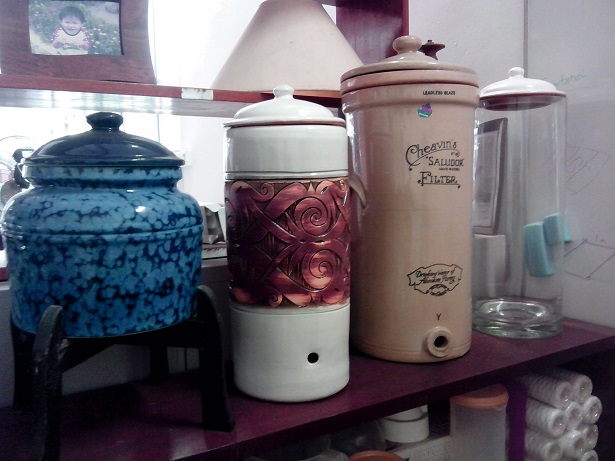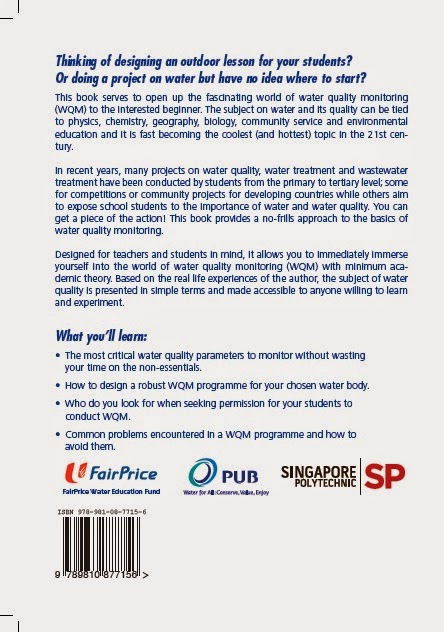I have been writing about getting water in emergencies for a while.
- Flooding in Queensland, Australia (2011): mad rush to buy food, water and other essentials
- Earthquake in Chile (2010): mad rush to loot food, water and other essentials
- Earthquake in Haiti (2010): looting; relief agencies provide water
- Others - Pakistan, New Zealand and use of British Berkefeld filter
- Use of Sawyer mini filter in an emergency
But in this post, I will focus on the production of potable water on a community scale in response to a disaster. This is based on my recent training experience with Indonesian Red Cross (aka Palang Merah Indonesia (PMI)) in Indonesia of course. As the country is a disaster magnet, PMI has become very adept at disaster management, including providing WASH (water, sanitation & hygiene) services.
PMI's current favourite water filtration unit is the French LMS system. Light (relatively as you still need 4 guys to carry a single filter), compact, modular - what's not to like about it? Especially when it can be freighted anywhere easily and deployed in 30min by a
trained crew.
 |
| Figure: Water Distribution device for the end users (aka beneficiaries affected by the disaster). Anyone feel like "milking these cows"? |
 |
| Figure: The engine/pump to suck in the raw water for treatment. BTW, there was no maid to help you get this working. You have to get your hands dirty to prep everything yourself. Remember the 3Fs - fuel, fluid (engine oil), fire (spark plug) and make sure all 3 are in good order before starting up. |
 |
| Figure: The activated carbon (AC) filter which needs 4 guys to carry around. Together with the sand filter (similar weight), they are rated to produce 4000L/h of water. This translates to enough water for 6400 beneficiaries assuming the system is working at full capacity and we are following Sphere standard of 15L of water per person per day. Hidden behind the main drum is a chlorinator (black box). |
 |
| Figure: Sand filter. This has to come before the AC filter. |
 |
| Figure: Trying to join everything together. Notice the 1000-L water bladder (in yellow) in the foreground. It is supposed to store the treated water before heading to the distribution device. |
 |
| Figure: Using a pool tester to check the chlorine residual and pH in the water. Together with turbidity, these 3 water quality parameters are the most commonly tested in such a scenario. |
 |
Figure: Very important! Everyone involved in setting up the filtration system must be on the same page (literally and figuratively) on where every component is placed. This layout sketch was used in our briefing and walkabout before everyone rushed off to their respective tasks.
|
My after-action thoughts
- I thought it would have been good to include an electrical conductivity (EC) meter to check the raw water. If its salinity was too high (> 2500uS/cm according to PMI standards), we would have sought an alternative water source instead of committing our efforts and time to set up the system only to get a salty tasting end product.
- Though not obvious in the photos, 2 chambers with attached mixers were used for coagulation and flocculation, respectively. We were provided with coagulation tablets (1 aluminium based and 1 iron based) and flocculation tablets (1 cationic polymer and 1 anionic polymer). Unfortunately, the instructions on their dosage were not clear i.e. how much to add under what conditions.
- No head/pressure calculations were done on the set-up. Perhaps too engineering for most people, it is still a good idea to know at least the maximum allowable suction lift (water source to pump) and elevation (pump to bladder). I certainly do not want to set up everything (we took less than an hour by the way) only to find not a single drop of water coming out in the bladder due to insufficient pressure provided by the pump.
- Not enough info on our water source - a pond within a fenced compound. I was rather concerned about the presence of ammonia (human waste, fertilisers from nearby?) and to a lesser extent, nitrate (anyone using fertilisers?). Some simple test strips should give us an answer but we did not have these available.
- What about solvents, petrochemicals, pesticides, heavy metals AND pathogens? Don't we have to check for them too? Admittedly, all the above contaminants are serious concerns but testing them in the field is impractical. Either they need sophisticated equipment requiring electrical power or they require specialised lab skills. And some require time e.g. bacteria count needs incubation of 24-28h, time which is usually lacking in a real emergency scenario.
Therefore, we have (hope?) to rely on our coagulation/flocculation, sand filtration, activated carbon and chlorination to remove them sufficiently in the final product.
 |
| Figure: My favourite EC meter. Durable and simple to use. Though it does not measure seawater, it is good enough for most purposes. |
 |
| Figure: Hach test strips for nitrate and nitrite. Also simple to use in the field |
 |
| Figure: Hach test strips for ammonia. Ditto. |
My greatest challenge in providing water at community level
Guess what? The most challenging problem has nothing to do with the technical aspects of the water system. And if you guess it is the human factor, you are absolutely right!
But before you start speculating about internal problems in our team, that is not it! Teamwork was great and I could not have wished for a better team.
Instead, before the actual deployment, we had to perform a needs analysis of the community, a survey of sorts on our beneficiaries. Though we were not in a real disaster, we did a survey of the villagers in the area as part of our training. They spoke Sunda, an Indonesian dialect and of course Bahasa. I certainly could not speak Sunda and my Bahasa is sikit sikit (little little). Fortunately, our survey team leader could converse in Malay (quite similar to Indonesian Bahasa) and that made all the difference. He could build the rapport needed for us to obtain valuable data about how the villagers manage their water, sanitation and hygiene.
To me, the
language barrier is a very real problem for community scale emergency water filtration.
 |
| Figure: Not your grandfather's car. This Landrover was used in carrying ALL our equipment (including water filters) into the village for deployment. Like the Energizer Bunny, it never stops, accomplishing the toughest jobs despite its beat-up appearance. |
 |
| Figure: Deployment ground within the village. Note the picturesque scenery in the background |


















No comments:
Post a Comment